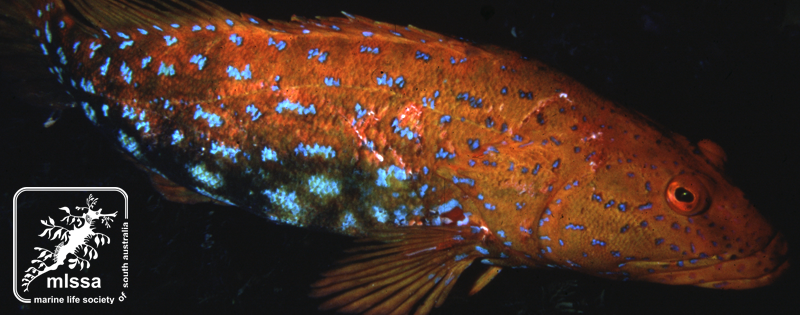
The Harlequin Fish (Othos dentex) is a southern Australian endemic with a limited geographic distribution (S.A. and W.A.), and a limited known depth range.
It is a site-associated on coastal reefs, over a narrow depth range, and has vulnerable population characteristics, similar to other species in the Serranidae family. Although there is a paucity of quantitative information about population sizes, it is likely that the relative abundance of this species in South Australia is much lower than in Western Australia.
There is concern that abundance may have declined over time in areas where water quality is reduced, and reefs are degraded. Harlequin Fish are caught by recreational fishermen, guests of charter fishing trips and (to a lesser extent) by commercial operators across its range by a number of methods.
Few controls are placed on its capture, particularly in South Australia, and no investigation of the potential impacts of fishing has been undertaken.

I have been lucky in the past to have seen the Harlequin Fish around the bottom reefs of Yorke Peninsula, unfortunately this was a long time ago. This fish was once prized by Spearfishermen but was cut from all competition’s due to trying to protect this species of beautiful fish.
Hi Ron, would your family consider becoming members of MLSSA, now that there are multiple divers in the family?
[…] Harlequin Fish […]
Harlequin Fish should undoubtedly receive full protection in all SA waters,as an urgent,obvious agenda and full protection would or should be so simple to achieve in legislative terms, yet that inertia we so often observe among our ‘top order legislators’ seems as resistive today as it’s seemed for decades. Ditto for our iconic site-associated Western Blue Groper,which must by any scientific assessment or criteria stand out as a key candidate for blanket protection.
Why are these two species not yet fully protected in SA?When I boil it down to the essence, I can think of only 2 realistic reasons:either there is vested interest by certain groups in our community against full protection,or there is insufficient public awareness of these fishes’ plight to spur our political representatives into action ie ‘not enough votes in it’.
Blue Groper are far more common than harlequin fish in SA.Harlequin are the fish that people need to be concerned about. Blue Groper are wrasses that breed rapidly. They are one of the most common species off Port Lincoln. I have been commercial abalone diving 41 years in the area and they are definitely not rare as some people claim.
Recently caught 3 large harlequin whilst snapper fishing in 25 metres near Cape Jervis SA, all returned. Estimate largest to be 40-45cm.
I wouldn’t call a 45 cm Harlequin Fish large. I’d put that in the small-medium adult size range.
Great they were RTW, and the charter industry does the same. There’s been no research or study I’m aware of as to survival rates following RTW for harlies, but its clearly the best option for any hooked harlequin fish. Wouldn’t it be nice if our fisheries management funded some basic study to validate the worth of return to water for this iconic species?
Better still, why not legislate for full protection?
Not forgetting it no longer occurs in Victoria, probably due 2 main factors: smaller total area of suitable habitat, and the very high fishing pressure inherent in that state’s much larger human population.
I’d love to see some more photos of this species! I’m an artist in Adelaide who specialises in marine life paintings. Feel free to email any photos to mjktberry@bigpond.com or find me on Facebook Jenny Berry Artist. Thanks!
I would think the Harlequin worthy of some form of protection. Current bag limit of 6 per boat is ill considered.They are far rarer than the Blue Groper Blue Groper are very common on the west coast of SA where I have worked as an abalone diver over 40 years..
Thanks Greg
Hi all I was surfing yesterday at triggs near Port Noarlunga and stepped on one of these fish as I was walking in.
It freaked out and bit me on the leg through my wetsuit, I have deep cuts and a photo to prove this. I thought it was a small bronze whaler but the teeth were super sharp i hit it with my hand it was red in colour about 40cm long.
Can anyone advise if it is poisonous and lucky for me it was a Harlequin fish and not something bigger !!!
Thanks for this report Simon. We hope that your cuts heal quickly. We haven’t heard about the Harlequin Fish being poisonous in any way. They are, however, very toothy.
Hi Simon,
Unlikely to have been a Harlequin in wading depth but not impossible( eg one recovering after catch and release might have drifted into shallows. I’m assuming incident occurred @ depth of ~1 metre or less from your account?).
Far more likely to have been a wobbegong of some sort, eg Ornate(Gulf) Wobbegong, Spotted Wobbegong or Cobbler Wobbegong (or feasibly but less likely a Draughtboard Shark).
All 4 can occur in very shallow rocky, weedy areas.
Color is a rather unreliable guide ,varying with location, age, surrounding terrain etc.
Also, Harlequins if stepped on would easily slip away without being pinned, whereas the wobbegongs are all flatter, easier to accidentally pin to the bottom with a foot, and very inclined to ‘bite sideways’ therefore causing lacerations more than puncture wounds.
My guess-and that’s all it is, although I’d like to see the injury photos which may help decide- is the fish that bit you was a young Ornate (aka Gulf aka Southern Banded) Wobbegong, Orectolobus halei.
I’m punting on that species ahead of other wobbegongs that are known to occur in shallow local waters here in S.A. partly because it seems to like VERY shallow reefs (well, the younger ones, anyway),but mainly because, of the main above options, it comes closest to looking reddish as a base color.( Yeah, I’m not listening to myself, am I …what’d I just say about color being unreliable?? !!…)
In my (amateur) experience the color of wobbegongs is very hard to describe reliably.
But Ornates (which are officially “brown with dark and pale marbling…” cf Fishes of Australia’s Southern Coast: Gomon Bray Kuiter 2008 ) can look rusty brown to almost pink on the back of the head ,and the broad flat pectoral fins are a bit darker.
And Ornate Wobbegongs have even broader heads( and wider mouths) in proportion to the total length so even a small one can deliver a nasty defensive bite.
Finally, for completeness sake, I’ve considered Estuary Catfish (aka Estuary Cobbler) because its common here, inhabits equally shallow areas, and often causes grief for waders. But they jab you with their venomous spines (very painful….personal experience!) rather than biting, so I’m sure we can exclude that one.
Sorry for such a lengthy comment.
I think you were bitten by Orectolobus halei.
I’m almost certain it was not a Harlequin Fish.
As for Western Blue Groper being common, hey, gotta disagree.
According to Pirsa-Sardi, also Reef Watch, and based on my own participation in several scientific surveys conducted in the early 2000s (headed by SARDI’s foremost marine ecologist at the time), Blue Groper are functionally extinct in GSV and data deficient in SG.
Adults[=60+ cm length/age 15+ years, at which stage they can begin breeding] are still encountered by divers in SG but mainly well to the SW ( eg Port Lincoln area, as Greg notes).Adults are more often seen by divers on the West Coast, so Abalone divers would indeed often see them.
The very young ones inhabit the shallowest areas of rocky coastline and are certainly far more common than adults. The very young ones however look so unlike the mature adults that most people don’t recognize them, plus they’re more wary, very flighty, less inquisitive…their very survival demands those attributes.
Recruitment from young to adult ie breeding age is very low, as with most wrasses, and is undoubtedly impacted by Recreational Fishing Pressure. On lower Yorke Peninsula that exceeds 60,000 boat hours annually!
I don’t know where the notion that wrasses are fast breeders came from but all scientific evidence says the opposite. Including all wrasses occurring naturally in southern Oz.
And, generally, the bigger wrasse species live longer and take many years even to attain reproductive age/size.
Western Blue Gropers can live for at least 60 years, and are(?were?) the top order site-associated(territorial) species of bony fish of rocky reefs in S.A.
They don’t start breeding till they’re about 15 years old.
THEY NEED PROTECTION!!
[…] Harlequin Fish […]